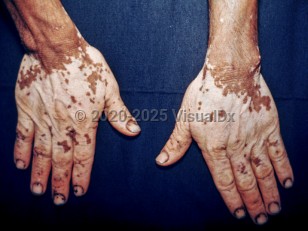Pinta
Alerts and Notices
Important News & Links
Synopsis

Pinta, also known as azul, carate, and mal de pinto, is a nonvenereal endemic treponemal infection caused by the spirochete Treponema pallidum subsp carateum. The disease is confined to rural areas of northern South America and Mexico. However, current prevalence data is lacking.
Pinta affects all age groups, as opposed to other endemic treponemal diseases for which children are the most often affected. Most cases are limited to the skin. Infection usually is spread by person-to-person contact in endemic areas by direct skin or mucous membrane contact.
Pinta infection is divided into 3 stages. After an incubation period of 7-30 days, the primary infection begins as one or several small papules, usually on the exposed surfaces of the extremities. Papules are typically painless but may be pruritic. These primary lesions enlarge over the course of 3-9 months to form secondary lesions, including scaly, reddish papules and sometimes psoriasiform plaques (pintids or psoriasiform pintids). Regional lymph nodes may be enlarged and painless or inflamed. Primary and secondary lesions are extremely infectious. Over time, the color of the lesions changes from copper to slate blue, and they eventually appear white (either hypo- or depigmented) and either macular or atrophic, marking onset of the third stage. In this stage, hyperkeratosis of the palms and soles may also be seen, along with atrophic plaques. Late-stage tertiary lesions are no longer infectious. Regional lymphadenopathy may persist in this stage.
Pinta affects all age groups, as opposed to other endemic treponemal diseases for which children are the most often affected. Most cases are limited to the skin. Infection usually is spread by person-to-person contact in endemic areas by direct skin or mucous membrane contact.
Pinta infection is divided into 3 stages. After an incubation period of 7-30 days, the primary infection begins as one or several small papules, usually on the exposed surfaces of the extremities. Papules are typically painless but may be pruritic. These primary lesions enlarge over the course of 3-9 months to form secondary lesions, including scaly, reddish papules and sometimes psoriasiform plaques (pintids or psoriasiform pintids). Regional lymph nodes may be enlarged and painless or inflamed. Primary and secondary lesions are extremely infectious. Over time, the color of the lesions changes from copper to slate blue, and they eventually appear white (either hypo- or depigmented) and either macular or atrophic, marking onset of the third stage. In this stage, hyperkeratosis of the palms and soles may also be seen, along with atrophic plaques. Late-stage tertiary lesions are no longer infectious. Regional lymphadenopathy may persist in this stage.
Codes
ICD10CM:
A67.9 – Pinta, unspecified
SNOMEDCT:
22064009 – Pinta
A67.9 – Pinta, unspecified
SNOMEDCT:
22064009 – Pinta
Look For
Subscription Required
Diagnostic Pearls
Subscription Required
Differential Diagnosis & Pitfalls

To perform a comparison, select diagnoses from the classic differential
Subscription Required
Best Tests
Subscription Required
Management Pearls
Subscription Required
Therapy
Subscription Required
References
Subscription Required
Last Reviewed:07/14/2021
Last Updated:07/18/2021
Last Updated:07/18/2021
Pinta

